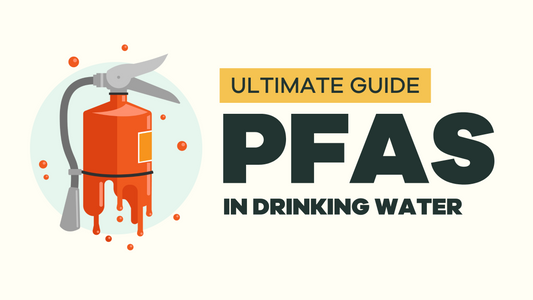
Aluminum and Alzheimer’s Disease: Is There a Link?
There is no single cause of Alzheimer’s disease.
Stemming from multiple factors, such as genetics, lifestyle, and the environment–researchers have identified many links to the development of the disease. Although some of the risk factors for Alzheimer’s cannot be changed (such as age, family history, etc.), we can influence other potential causes of the neurodegenerative illness. Environmental exposure is one of those risks we can better manage.
Environmental pollutant exposure does not equate to health risk in a linear way, which is why the science of how the environment impacts our health is so complex. That being said, our team of scientists at Tap Score confidently ascertain that reducing your exposure to harmful toxicants is likely to lower your risk of associated health outcomes.
While there are virtually limitless environmental toxicants, one in particular has been situated in the hot seat when it comes to discussing Alzheimer’s disease: aluminum.
In this newest Tips for Taps article, article, we look at:
- The current state of Alzheimer’s disease research
- Possible links between environmental factors and Alzheimer’s disease
What Is Alzheimer’s Disease?
When first identified in 1906, Alzheimer’s was considered to be a rare disorder. However, today this is far from the case.
Alzheimer’s disease is currently recognized as the most common cause of dementia-–with an estimated 5.3 million Americans suffering from the disease.[1],[2] While the majority (~5.1 million) of Alzheimer’s patients are over the age of 65, the Alzheimer’s Association estimates that anywhere from 200,000 to 500,000 people younger than 65 have early-onset Alzheimers and other forms of dementia.[3]
What Are The Signs and Symptoms of Alzheimer’s Disease?
A progressive and neurodegenerative condition, Alzheimer's disease occurs when nerve cells in the brain die, according to the National Institute of Neurological Disorders and Stroke.[4] Symptoms often include:[1]
- Impaired memory, thinking, and behavior
- Confusion
- Restlessness
- Personality and behavior changes
- Impaired judgment and communication communication
- Language deterioration
- Emotional apathy
Alzheimer’s changes the brain, which loses healthy cells and shrinks over the course of the disease, as damaged cells die. There are two hallmark types of brain cell damage:
Neurofibrillary tangles: These are twisted fibers inside brain cells that prevent nutrients from moving through cells.
Beta-amyloid plaques: These plaques are clumps of proteins that build up between nerve cells, rather than break down as they should in healthy brains.
These two types of damage harm the healthy brain cells around them, as well.
Risk Factors For Alzheimer’s Disease:
As we mentioned, there is no clear cause of Alzheimer’s disease. However, the following risk factors have all been linked to the development and/or progression of the disease:[5]
- Age (risk increases as you get older)
- Gender (women are more commonly affected)
- Family history
- Head injury
While not listed as a possible risk factor above, one of the most popular hypotheses is the potential link to aluminum exposure.
In the last 50 years, aluminum has become a possible suspect in contributing to the development of Alzheimer’s–fostering concerns about everyday exposure to aluminum through foil, antiperspirants, beverage cans, and beyond.
Aluminum and Alzheimer’s: Current State of Research
The literature remains inconclusive in linking aluminum to Alzheimer’s disease. According to the Alzheimer’s Association: “Almost all scientists today focus on other areas of research, and few experts believe that everyday sources of aluminum pose any threat.” [6]
However, research is ongoing.
Aluminum is the most abundant neurotoxic metal on earth and repeatedly shown to bioaccumulate. The role of aluminum in Alzheimer’s disease, however, remains strongly disputed.
Aluminum has drawn extra attention in recent years due to a number of studies clarifying the building evidence linking chronic aluminum exposure to the development of Alzheimer’s disease.[7] Evidence to suggest the link includes:
- Patients with Alzheimer’s disease have been found to have significantly elevated levels of aluminum in the brain, serum, and cerebrospinal fluid
- Aluminum bioaccumulates in cells, eventually producing changes that result in loss of function and atrophy consistent with MRI findings in the brains of Alzheimer’s patients [8]
This has led some researchers to believe that elevated aluminum levels may serve as an early marker of Alzheimer’s and/or play a role in its development or progression.
However, there have also been numerous studies that fail to prove any correlation or causation in regards to aluminum and Alzheimer’s disease. The counter arguments to support that there is no link are generally predicated upon the following claims:[9]
- Bioavailable aluminum cannot enter the brain in sufficient amounts to cause damage
- Excess Aluminum is efficiently excreted from the body
- Aluminum accumulation in neurons is a consequence rather than a cause of neuronal loss (typical of Alzheimer’s disease)
This mixed evidence has left the scientific community not entirely convinced. That being said, research continues.
How to Reduce Your Risk of Alzheimer’s and Dementia:
While as we mentioned, there is no one single cause for Alzheimer’s. Aging is the largest risk factor for developing the disease, and even though that’s something you cannot change, there are things you can do to limit other risk factors. The Alzheimer’s Society lists the following six steps you can take:[10]
- Be physically active
- Eat a healthy and balanced diet
- Don’t smoke
- Limit your alcohol intake
- Exercise your mind
- See your doctor if you are concerned about any potential health problems
As far as aluminum, the jury is still out. While some studies have concluded that aluminum may be linked to a risk of dementia, many others fail to prove correlation. That being said, because there are no definitive findings to date, we suggest being aware of possible routes of excessive environmental toxicant exposure (including aluminum).
There have been a handful of analyses looking specifically at aluminum levels in drinking water and the risk of dementia.The evidence remains mixed and inconclusive. It has also been noted that other elements present in drinking water–fluoride, copper, zinc, or iron–may impact cognitive function.
Wondering if your tap water is putting you at risk? Put it to the test.
Essential City Water Test
Basic test panel for water utility customers primarily concerned by metals, aging pipes, and infrastructure.
For our full collection of drinking water tests, take a look here.
Every Tap Score Report includes a detailed (yet easy to understand) breakdown of what contaminants are found in your water, rich health-risk analysis, local water quality comparisons, and steps you can take (with specific, customized, and unbiased treatment recommendations) to improve your water. We don’t partner with treatment companies, so we recommend the best fit to correct your water’s unique chemistry. Take a look at an example Tap Score Report here.
Have more questions? Our team of water quality experts, chemists, and engineers is always standing by.
Read More
▾The Exposome: How Environmental Exposures Impact Your Health – SimpleLab Tap Score
What is Toxicology? | SimpleLab Tap Score
7 Heavy Metals Everyone Should Test For | SimpleLab Tap Score
Sources and References
▾- General Neurology Treatment
- What is Dementia? Symptoms, Causes & Treatment | alz.org
- Young-onset Alzheimer's: When symptoms begin before age 65 - Mayo Clinic
- National Institute of Neurological Disorders and Stroke
- Risk Factors for Alzheimer's Disease: A Prospective Analysis from the Canadian Study of Health and Aging | American Journal of Epidemiology | Oxford Academic
- Causes and Risk Factors for Alzheimer's Disease
- Aluminum Levels in Brain, Serum, and Cerebrospinal Fluid are Higher in Alzheimer's Disease Cases than in Controls: A Series of Meta-Analyses
- Chronic aluminum intake causes Alzheimer's disease: applying Sir Austin Bradford Hill's causality criteria
- Aluminum and Alzheimer's disease: after a century of controversy, is there a plausible link?
- How to reduce your risk of Alzheimer's and other dementias








